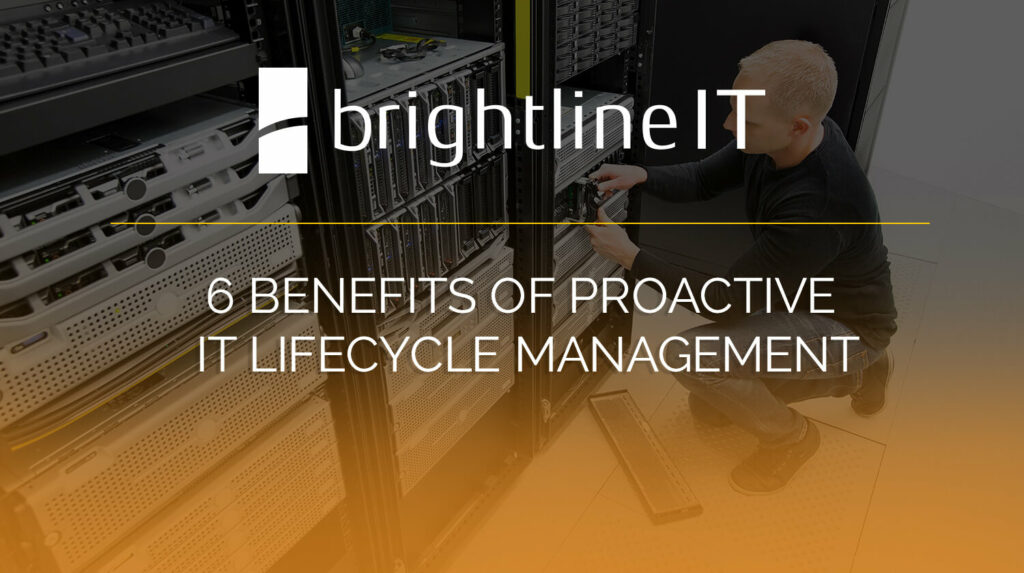Effective IT lifecycle management can help your business plan for the future.
No purchase lasts forever—especially when it comes to IT. As technology continues to evolve, both the underlying hardware systems and the user-facing software applications need to be regularly upgraded if they are to keep up.
However, the timing of these upgrades is hard to predict. Both hardware and software systems can have varying longevity depending on what purposes they were designed to fulfill. And while many businesses can get by for a while without having to consider these systems too deeply, neglecting them will eventually result in the system crashing or failing altogether.
The area of IT that specializes in handling the acquisition, installation, maintenance, and eventual decommissioning and replacement of IT assets is known as “lifecycle management.” Without resources devoted to this aspect of IT management, businesses could find themselves ill-equipped to navigate business challenges in the future, or to take advantage of new opportunities as they arize. Here are six reasons why IT lifecycle management is so important to businesses.
1. Forecast your hardware and software needs for better budgeting.
Planning for future expenditures is a crucial part of running a successful business. While many software services are moving toward a service model that runs on a monthly subscription, other enterprise applications still represent a multi-thousand-dollar investment in some industries. Hardware systems, including computers, routers, and wiring upgrades, are no less significant an investment, both in importance and in resources required.
Business owners who want to expand their office footprint or hire new employees need to have the reassurance that their IT systems won’t fail shortly after making these major capital expenditures. Lifecycle management oversees these systems to ensure that owners and CFOs can make informed financial decisions that take IT systems fully into account.
2. Reduce unexpected downtime by replacing IT infrastructure before it fails.
When IT infrastructure fails, it can quickly grind your business to a halt. Employees can no longer access the information they need to do their job, customer complaints begin to flood in, and the business begins losing revenue. If this happens during the middle of a busy workday, the consequences can be dire.
Many businesses plan on some amount of downtime over the course of the year, but only under circumstances they can control. Unexpected failures can happen as the consequences of natural events, a security breach, or human error. But IT infrastructure failing because it has reached the end of its life and hasn’t been replaced in time is one of the more common—and preventable causes.
3. Avoid delays caused by outdated software and hardware.
It doesn’t take a crisis for outdated IT infrastructure to start costing your business money. Slow networks, burdensome work-arounds, or crashing software can all lead to lost productivity and increased frustration among employees. This can be especially problematic if the underlying issue leads to additional problems.
As an example: a software program keeps crashing because the OS on the computer is outdated. Meanwhile, the OS can’t be updated because the computer hardware is too old to support the newest version. The software crashes while an employee is working on an important file, and the latest version can’t be retrieved because the file has been corrupted. The employee now has to re-do hours of work, and the team falls behind in their project.
It’s a common scenario, but one that can be easily avoided by ensuring that employees have the hardware and software necessary to complete their jobs.
4. Make informed purchasing decisions before a crisis forces your hand.
Another consequence of poor lifecycle management lies in an IT failure precipitating an unplanned IT investment. Decisions made under pressure are rarely the right ones for a business, but in an emergency, many businesses lack the flexibility to run their due diligence.
By proactively managing your system lifecycle, you can research the best IT purchases when you have the freedom to dig into the details and understand the pros and cons of each choice.
5. Understand the true cost of ownership, including maintenance and repairs.
How much do your IT systems actually cost your business? One of the reasons many businesses put off upgrading their systems is because they have miscalculated the cost of ownership. Perhaps they had a budget to upgrade their network to fiber-optic Internet at one point, but their computer hardware failed first and the budget went to fixing that problem instead.
Understanding the cost of IT resources throughout their lifecycle is part of making informed purchasing decisions for your business. By planning for these costs, you can avoid being caught flat-footed by an unexpected repair bill.
6. Prevent security failures that result from outdated systems.
Finally, old networks are a prime target for hackers and malware. In particular, out-of-date software poses a major security risk for businesses, as many updates are designed to push security patches for known vulnerabilities. When a vulnerability is exploited, the results can be severe for a business. It can mean lost data if the virus causes a system to shut down, damaged customer relations if the breach affects user data, and even legal consequences if the business is shown to have failed compliance regulations.
By keeping networks up to date, businesses can protect themselves from security threats and avoid a PR nightmare.
Managed IT professionals can help you maintain your systems.
For many business owners, keeping track of the lifecycle of hardware and software systems is a complex task that takes away from the attention they would otherwise be expending on other areas of their business. As a business specializing in managed IT, Brightline can help your organization keep track of its IT assets so that your systems never fall out of date. Contact us today for more information.
